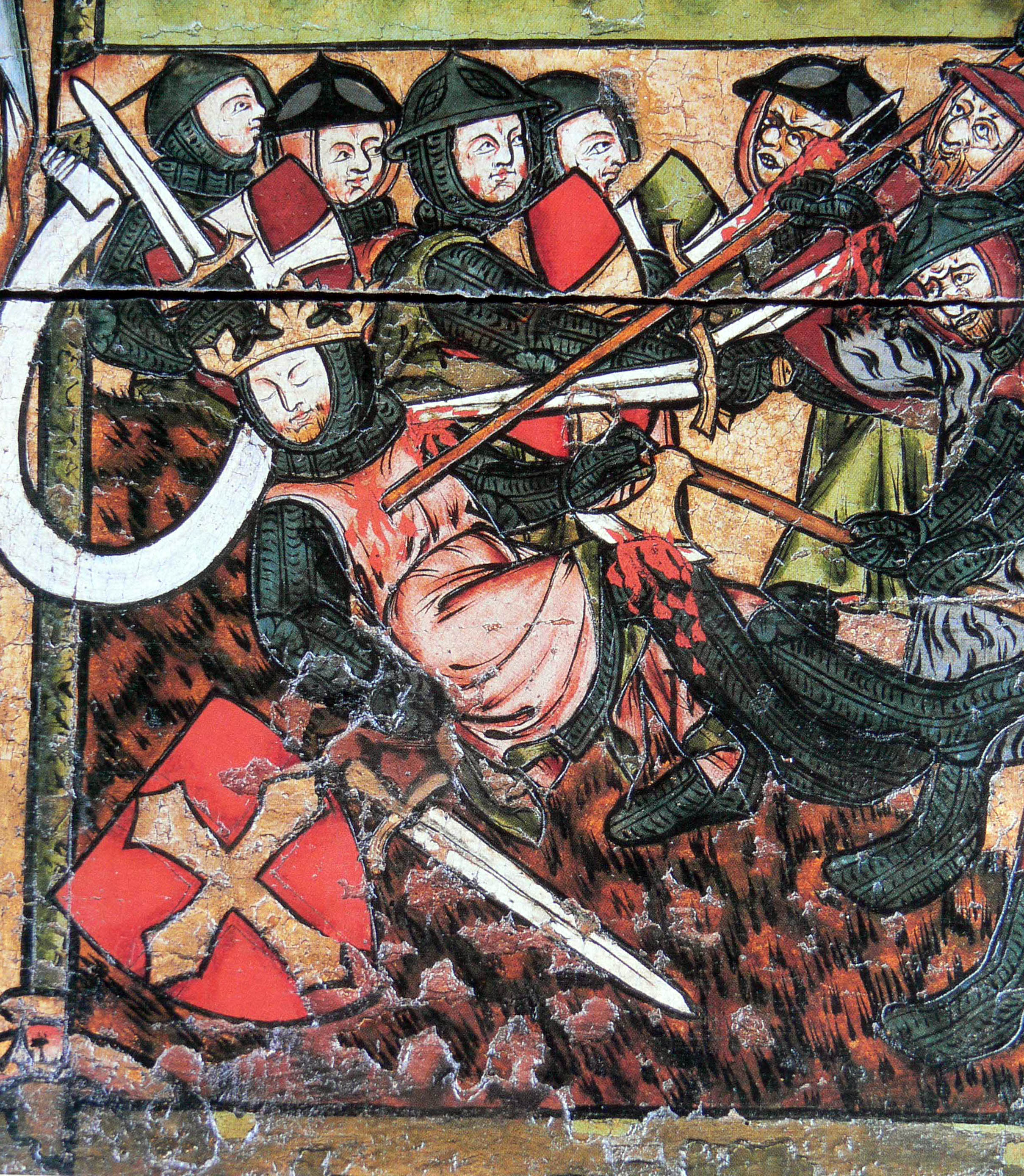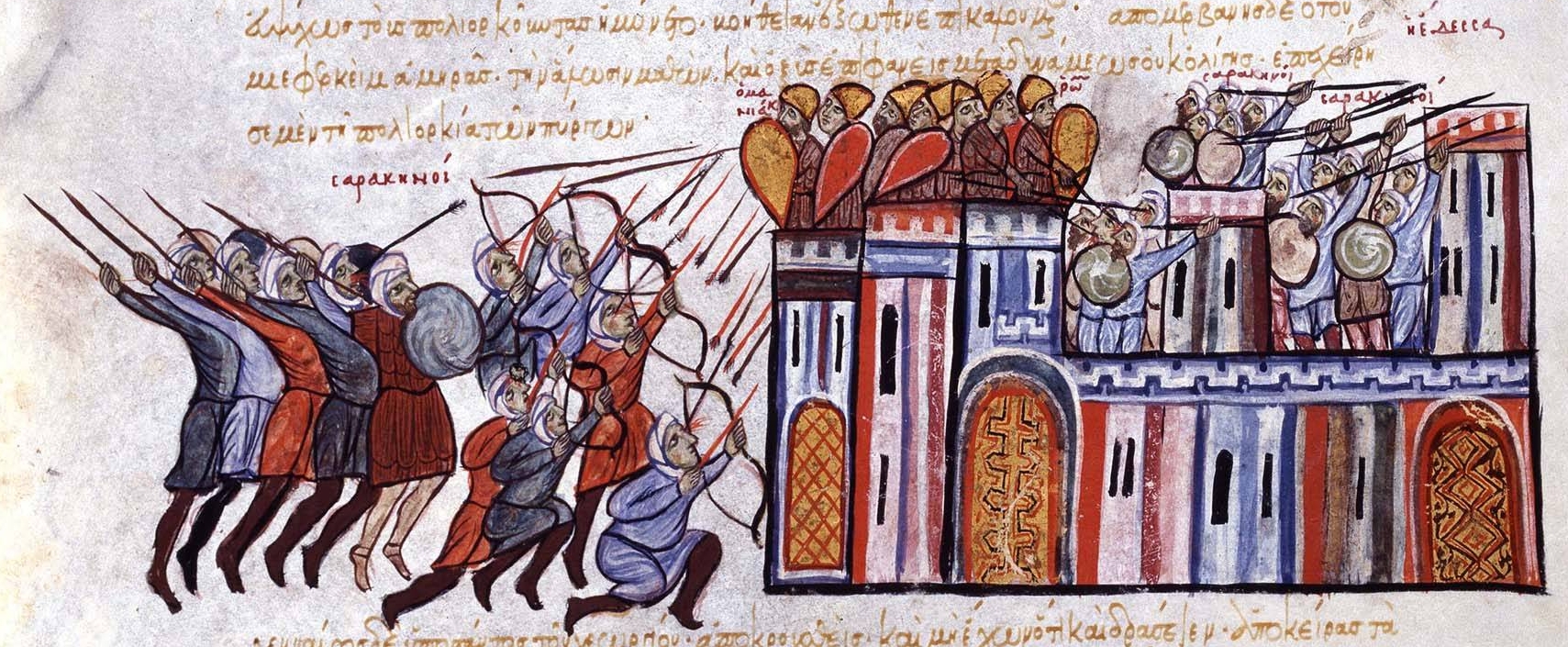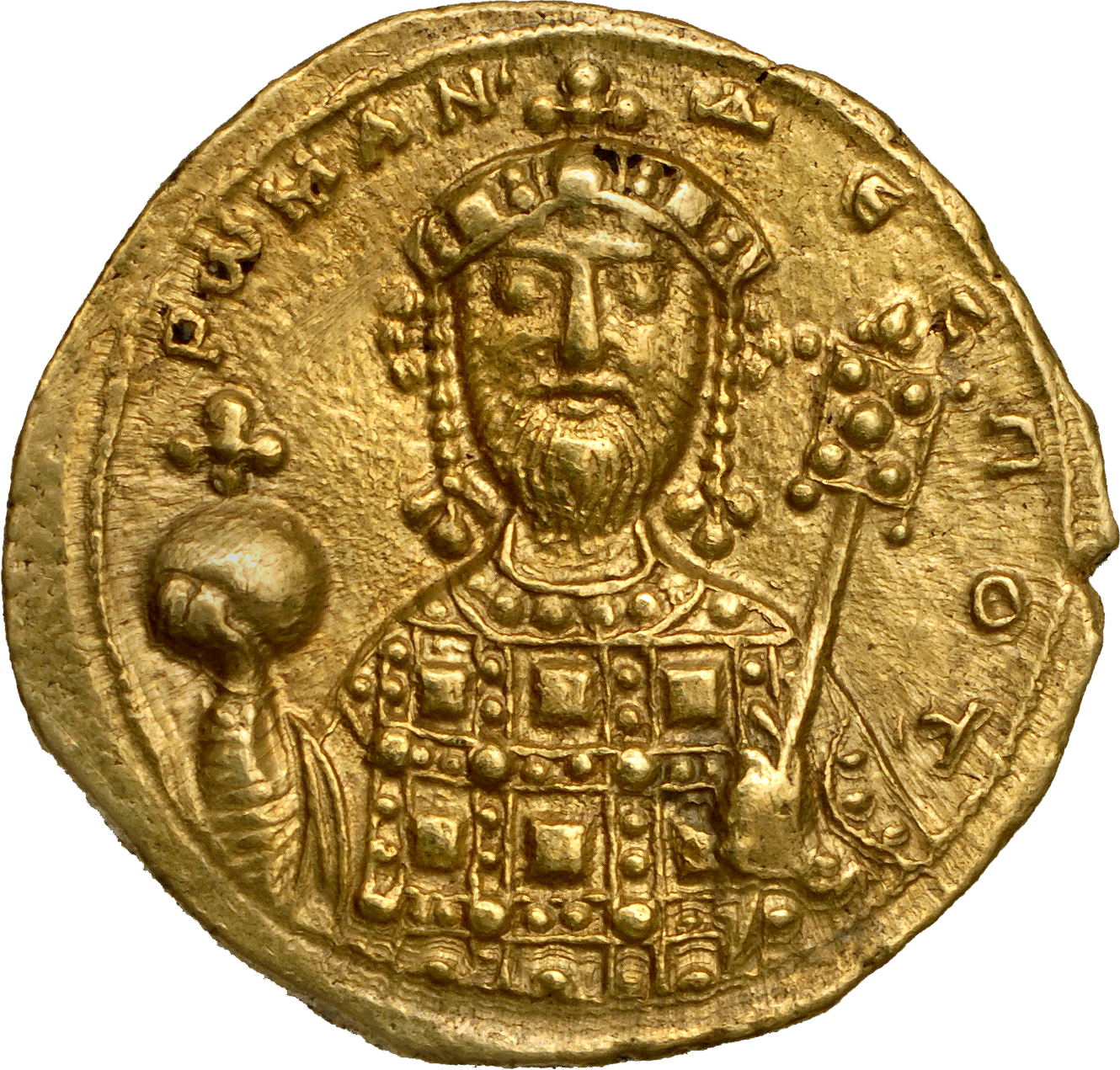|
1030
Year 1030 ( MXXX) was a common year starting on Thursday (link will display the full calendar) of the Julian calendar. Events By place Byzantine Empire * Emperor Romanos III Argyros decides to retaliate upon the incursions of the Muslims on the eastern frontier. He leads a Byzantine expeditionary force (20,000 men) to secure Antioch. The Mirdasid emir Shibl al-Dawla Nasr of Aleppo sues for peace, but Romanos refuses to negotiate and leads his army against Aleppo, against the advice of his generals. The Byzantine army encamps near Azaz, where they are encircled by the Mirdasids' Bedouin troops, who cut off the Byzantines from food and water. * 10 August – Romanos orders a retreat to Antioch. As the army is exhausted from the heat and the lack of supplies, the retreat soon turns into a flight in panic. Romanos returns to Constantinople in humiliation but his generals on the eastern frontier manage to salvage the situation: a Fatimid attack on Maraclea is repulsed, ... [...More Info...] [...Related Items...] OR: [Wikipedia] [Google] [Baidu] |
Battle Of Stiklestad
The Battle of Stiklestad ( no, Slaget på Stiklestad, non, Stiklarstaðir) in 1030 is one of the most famous battles in the history of Norway. In this battle, King Olaf II of Norway () was killed. During the pontificate of Pope Alexander III, the Roman Catholic Church declared Olaf a saint in 1164. His younger half-brother, Harald Hardrada (), was also present at the battle. Harald was only fifteen when the battle of Stiklestad took place. He became King of Norway in 1047, until his death in a failed invasion of England at the Battle of Stamford Bridge in 1066. The authenticity of the battle as a historical event is subject to question. Contemporary sources say the king was murdered. According to the '' Anglo Saxon Chronicle'' of 1030, Olaf was killed by his own people. Adam of Bremen wrote in 1070 that Olaf was killed in an ambush, and so did Florence of Worcester in 1100. Those are the only contemporary sources that mention the death of the king. After the king's canoniza ... [...More Info...] [...Related Items...] OR: [Wikipedia] [Google] [Baidu] |
Shibl Al-Dawla Nasr
Abu Kamil Nasr ibn Salih ibn Mirdas () (died 22 May 1038), also known by his ''laqab'' (honorific epithet) of Shibl al-Dawla ('Lion cub of the Dynasty'), was the second Mirdasid emir of Aleppo, ruling between 1029/1030 until his death. He was the eldest son of Salih ibn Mirdas, founder of the Mirdasid dynasty. Nasr fought alongside his father in the Battle of al-Uqhuwana near Tiberias in 1029, where Salih was killed by a Fatimid army led by Anushtakin al-Dizbari. Afterward, Nasr ruled the emirate jointly with his brother Thimal. The young emirs soon after faced a large scale Byzantine offensive led by Emperor Romanos III. Commanding a much smaller force of Bedouin horsemen, Nasr routed the Byzantines at the Battle of Azaz in 1030. After his victory, Nasr ousted Thimal from Aleppo and entered into Byzantine vassalage, while maintaining ties with the Fatimids. He nominally recognized Fatimid suzerainty in 1037 and was concurrently given control of Hims, which the Mirdasids had los ... [...More Info...] [...Related Items...] OR: [Wikipedia] [Google] [Baidu] |
Olaf II Of Norway
Olaf II Haraldsson ( – 29 July 1030), later known as Saint Olaf (and traditionally as St. Olave), was King of Norway from 1015 to 1028. Son of Harald Grenske, a petty king in Vestfold, Norway, he was posthumously given the title ''Rex Perpetuus Norvegiae'' ( en, Eternal/Perpetual King of Norway) and canonised at Nidaros (Trondheim) by Bishop Grimkell, one year after his death in the Battle of Stiklestad on 29 July 1030. His remains were enshrined in Nidaros Cathedral, built over his burial site. His sainthood encouraged the widespread adoption of Christianity by Scandinavia's Vikings/Norsemen. Pope Alexander III confirmed Olaf's local canonisation in 1164, making him a recognised saint of the Catholic Church and started to be known as ''Rex Perpetuus Norvegiae'' – ''eternal king of Norway''. Following the Reformation he was a commemorated historical figure among some members of the Lutheran and Anglican Communions. The saga of Olav Haraldsson and the legend of Olaf the S ... [...More Info...] [...Related Items...] OR: [Wikipedia] [Google] [Baidu] |
Battle Of Azaz (1030)
The Battle of Azaz was an engagement fought in August 1030 near the Syrian town of Azaz between the Byzantine army, led by Emperor Romanos III Argyros () in person, and the forces of the Mirdasid Emirate of Aleppo, likewise under the personal command of Emir Shibl al-Dawla Nasr (). The Mirdasids defeated the much larger Byzantine army and took great booty, even though they were eventually unable to capitalise on their victory. Aleppo had long been a flashpoint between Byzantium and its Arab neighbours, with the Byzantines claiming a protectorate over the city since 969. In the aftermath of a defeat inflicted on the Byzantine governor of Antioch by the Mirdasids, Romanos launched a campaign against Aleppo. Despite his own inexperience in military matters, Romanos decided to lead the army in person, leading contemporary Byzantine chroniclers to point to a quest for military glory as his primary motivation, rather than the preservation of the status quo. At the head of his army, ... [...More Info...] [...Related Items...] OR: [Wikipedia] [Google] [Baidu] |
Conrad II, Holy Roman Emperor
Conrad II ( – 4 June 1039), also known as and , was the emperor of the Holy Roman Empire from 1027 until his death in 1039. The first of a succession of four Salian emperors, who reigned for one century until 1125, Conrad ruled the kingdoms of Germany (from 1024), Italy (from 1026) and Burgundy (from 1033). The son of Franconian count Henry of Speyer (also Henry of Worms) and Adelaide of Metz of the ''Matfriding dynasty'', that had ruled the Duchy of Lorraine from 959 until 972, Conrad inherited the titles of count of Speyer and Worms during childhood after his father had died around the year 990. He extended his influence beyond his inherited lands, as he came into favor of the princes of the kingdom. When the imperial dynastic line was left without a successor after Emperor Henry II's death in 1024, on 4 September an assembly of the imperial princes appointed the 34-year-old Conrad king (''Rex romanorum''). Conrad II Ottonian adopted many aspects of his Ottonian predece ... [...More Info...] [...Related Items...] OR: [Wikipedia] [Google] [Baidu] |
Tartu
Tartu is the second largest city in Estonia after the Northern European country's political and financial capital, Tallinn. Tartu has a population of 91,407 (as of 2021). It is southeast of Tallinn and 245 kilometres (152 miles) northeast of Riga, Latvia. Tartu lies on the Emajõgi river, which connects the two largest lakes in Estonia, Lake Võrtsjärv and Lake Peipus. From the 13th century until the end of the 19th century, Tartu was known in most of the world by variants of its historical name Dorpat. Tartu, the largest urban centre of southern Estonia, is often considered the "intellectual capital city" of the country, especially as it is home to the nation's oldest and most renowned university, the University of Tartu (founded in 1632). Tartu also houses the Supreme Court of Estonia, the Ministry of Education and Research, the Estonian National Museum, and the oldest Estonian-language theatre, Vanemuine. It is also the birthplace of the Estonian Song Festivals. Tar ... [...More Info...] [...Related Items...] OR: [Wikipedia] [Google] [Baidu] |
Anund Jakob
Anund Jacob or James, Swedish: ''Anund Jakob'' was King of Sweden from 1022 until around 1050. He is believed to have been born on July 25, in either 1008 or 1010 as ''Jakob'', the son of King Olof Skötkonung and Queen Estrid. Being the second Christian king of the Swedish realm, his long and partly turbulent reign saw the increasing dissemination of Christianity as well as repeated attempts to influence the balance of power in Scandinavia. Through out his regin he tried to subvert the rising Danish hegemony in Scandinavia by supporting the Norwegian monarchy. He also supported the reign of Yaroslav the Wise in Kievan Rus, his brother-in-law. He is referred to in positive terms in German and Norse historical sources. His reign was one of the longest in Sweden during the Viking Age and Middle Ages. Accession The main sources for Anund Jacob's reign are the near-contemporary ecclesiastic chronicle of Adam of Bremen and several Norse histories from the 12th and 13h centuries, in par ... [...More Info...] [...Related Items...] OR: [Wikipedia] [Google] [Baidu] |
Stephen I Of Hungary
Stephen I, also known as King Saint Stephen ( hu, Szent István király ; la, Sanctus Stephanus; sk, Štefan I. or Štefan Veľký; 975 – 15 August 1038), was the last Grand Prince of the Hungarians between 997 and 1000 or 1001, and the first King of Hungary from 1000 or 1001, until his death in 1038. The year of his birth is uncertain, but many details of his life suggest that he was born in, or after, 975, in Esztergom. He was given the pagan name Vajk at birth, but the date of his baptism is unknown. He was the only son of Grand Prince Géza and his wife, Sarolt, who was descended from a prominent family of '' gyulas''. Although both of his parents were baptized, Stephen was the first member of his family to become a devout Christian. He married Gisela of Bavaria, a scion of the imperial Ottonian dynasty. After succeeding his father in 997, Stephen had to fight for the throne against his relative, Koppány, who was supported by large numbers of pagan warriors. He defea ... [...More Info...] [...Related Items...] OR: [Wikipedia] [Google] [Baidu] |
Romanos III Argyros
Romanos III Argyros ( el, Ρωμανός Αργυρός; Latinized Romanus III Argyrus; 968 – 11 April 1034), or Argyropoulos was Byzantine Emperor from 1028 until his death. He was a Byzantine noble and senior official in Constantinople when the dying Constantine VIII forced him to divorce his wife and marry the emperor's daughter Zoë. Upon Constantine's death three days later, Romanos took the throne. Romanos has been recorded as a well-meaning but ineffective emperor. He disorganised the tax system and undermined the military, personally leading a disastrous military expedition against Aleppo. He fell out with his wife and foiled several attempts on his throne, including two which revolved around his sister-in-law Theodora. He spent large amounts on the construction and repair of churches and monasteries. He died after six years on the throne, allegedly murdered, and was succeeded by his wife's young lover, Michael IV. Life Family and early career Romanos Argyros, bor ... [...More Info...] [...Related Items...] OR: [Wikipedia] [Google] [Baidu] |
Germany
Germany,, officially the Federal Republic of Germany, is a country in Central Europe. It is the second most populous country in Europe after Russia, and the most populous member state of the European Union. Germany is situated between the Baltic and North seas to the north, and the Alps to the south; it covers an area of , with a population of almost 84 million within its 16 constituent states. Germany borders Denmark to the north, Poland and the Czech Republic to the east, Austria and Switzerland to the south, and France, Luxembourg, Belgium, and the Netherlands to the west. The nation's capital and most populous city is Berlin and its financial centre is Frankfurt; the largest urban area is the Ruhr. Various Germanic tribes have inhabited the northern parts of modern Germany since classical antiquity. A region named Germania was documented before AD 100. In 962, the Kingdom of Germany formed the bulk of the Holy Roman Empire. During the 16th ce ... [...More Info...] [...Related Items...] OR: [Wikipedia] [Google] [Baidu] |
Azaz
Azaz ( ar, أَعْزَاز, ʾAʿzāz) is a city in northwest Syria, roughly north-northwest of Aleppo. According to the Syria Central Bureau of Statistics (CBS), Azaz had a population of 31,623 in the 2004 census.General Census of Population and Housing 2004 . Syria Central Bureau of Statistics (CBS). Aleppo Governorate. , its inhabitants were almost entirely s, mostly but also some [...More Info...] [...Related Items...] OR: [Wikipedia] [Google] [Baidu] |
Mirdasid
The Mirdasid dynasty ( ar, المرداسيون, al-Mirdāsiyyīn), also called the Banu Mirdas, was an Arab dynasty which ruled an Aleppo-based emirate in northern Syria and the western Jazira (Upper Mesopotamia) more or less continuously from 1024 until 1080. History Dominance of the Kilab in northern Syria The Mirdasids were a family of the Bedouin (nomadic Arab) tribe of Banu Kilab. The Kilab's ancestral home was in central Arabia and its tribesmen first established themselves in northern Syria and the western Jazira (Upper Mesopotamia) in the years after the 630s–Muslim conquest. A second major wave of Kilabi tribesmen migrated to northern Syria from Arabia in the 9th century. The political vacuum and frequent revolts throughout the region during that period paved the way for the Kilab to strengthen their influence, becoming the predominant tribe in the region north of the Palmyrene steppe and west of the Euphrates River by the early to mid-10th century. A third maj ... [...More Info...] [...Related Items...] OR: [Wikipedia] [Google] [Baidu] |







